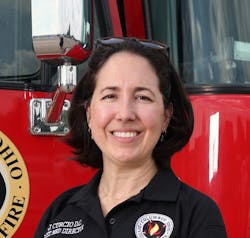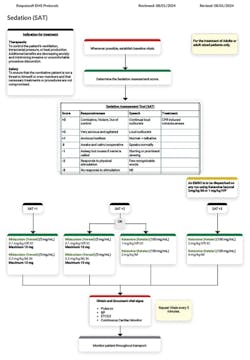Simplifying Prehospital Agitation Management with the Sedation Assessment Tool
Managing an agitated or aggressive patient is one of the myriad difficult situations in which prehospital providers can find themselves on any shift. Many times, verbal de-escalation tactics are enough to calm a patient to perform a hands-on assessment and emergency treatment, but it isn’t unusual—and it’s becoming more common—that physical restraint and sedation is indicated medically.
After several high-profile cases that involved adverse events around the use of sedation, a spotlight was placed on agitated and aggressive patients and the ability to manage them in the prehospital environment. Several medical associations published position statements, including the National Association of EMS Physicians (NAEMSP) and the American College of Emergency Physicians, in which best practices for managing these difficult and medically vulnerable patients are cited. All of the position statements are clear: The goals of prehospital sedation are the safety of the patient; facilitating rapid assessment, treatment and medical management; and protecting the public and responding providers.
As noted by Leonie Calver and her fellow authors in “Sedation assessment tool to score acute behavioural disturbance in the emergency department” (Emergency Medicine Australasia, 2011), an agency should have a patient-centered protocol that’s overseen and approved by the medical director. The use of an agitation score in the initial assessment and reassessment of the patient also was recommended. The Richmond Agitation Sedation Scale (RASS) was the most common, quickly adopted tool by many EMS agencies and charting programs, but its development and practice is in assessment of ICU-type patients, and its utility in the EMS environment hasn’t undergone study.
The Sedation Assessment Tool (SAT) score is a more appropriate tool for the prehospital setting.
Agitated patients
Before delving into the appropriate use of sedation, it’s important to understand what defines an “agitated patient” and the complexities of treating this patient population.
First and foremost, EMS providers must recognize that these are high-risk patients who are in need of a thorough medical assessment. Most definitions of an agitated patient cite psychomotor excitability, with the chance of aggressive or violent behavior that can cause disruption in the ability to care for the patient.
In reality, patients present on a spectrum from slight irritability or anxiousness to combative or even violent behavior. Causes of the agitation remain broad and can include such medical causes as hypoglycemia, sepsis, seizure and postictal state, traumatic head injuries and spontaneous intracranial bleeds. Some of these can be evaluated and treated in the prehospital environment, but some and a host of other causes require urgent emergency department evaluation.
In short, these patients should be recognized and treated as “altered mental status” patients, and medical causes must be treated or ruled out in an expeditious manner.
Concomitant psychiatric illness and drug toxidrome further complicate patient management, but the suspected presence of these conditions doesn’t preclude the obligation for assessment of other medical underlying causes.
Sedation
Historically, agitated patients were defined using a constellation of symptoms with intolerance to pain, superhuman strength, rapid breathing, sweating, hyperthermia and tachycardia. These patients were thought to have a syndrome labelled “excited delirium.” Although it’s appropriate to acknowledge the previous, historical use of the syndrome known as excited delirium, recent medical and lay literature raise questions about the medical validity of the syndrome as a diagnosis or distinct entity. Medicine and medical evaluation and treatment of patients is an ever-evolving science. It’s imperative as practitioners of prehospital medicine that we also update knowledge, practice and competencies. As such, we believe that the use of excited delirium as an independent syndrome or diagnosis should be retired from practice.
When patients are cared for in the prehospital environment, the primary goal is to assess for immediate life-threatening conditions and to treat field-reversable causes while protecting the patient from further medical decline and additional physical harm from the primary condition. The protection of bystanders and crews is a concurrent objective, too. To accomplish this, sedation often is necessary.
The use of sedation must balance the medical need and tenets of implied consent in a patient who lacks medical capacity with the dignity of the patient. Although the use of physical restraints plays a role, it should be recognized that physical restraints have the potential to be harmful.
EMS providers also must ensure that the use of sedation is a medically indicated procedure and never is intended to be punitive or simply for detention of individuals.
The decision to use or not use any sort of physical restraint or sedation in prehospital medicine is made for medically indicated reasons, based on the judgement by medical providers who have appropriate training and oversight.
SAT score
Once a determination is made that a patient needs sedation, how is this done objectively and safely? NAEMSP recommends using an agitation score for initial assessment and reassessment. We, too, believe that using an objective scoring tool is paramount for standardizing treatment. Frankly, we believe the ability to remove some of the heightened emotional aspects from the determination of medications produces consistent approaches and dosing to the patients.
For the field medic, this scoring tool must be quick, easy to administer, widely applicable, reproducible and reliable. Although there are many available scores in medicine, all have been developed as hospital-based tools, often with a depth and breadth that isn’t adaptable easily to the prehospital setting. For example, the RASS score mentions pulling at tubes and catheters as an example of an aggressive patient score. In the prehospital setting, patients might be pacing or too aggressive to even obtain an intravenous line.
The SAT is a seven-point scale that’s used primarily in Australia, first in emergency departments and then transitioned for prehospital use because of the similarity of the patient population. It’s a completely observational scale that uses only two descriptors—speech and responsiveness—that can be applied rapidly to initial patient assessment and reassessment. In fact, Calver and her fellow authors found a median time of 10 seconds to determine the SAT score. We believe that this aligns much more appropriately with the needs of a prehospital operational environment to the benefit of patients and providers.
The simplicity of the scoring and the previous experience led us to adopt the SAT score as our prehospital scoring tool. Again, the goal was an easily and consistently used and reproducible tool for our providers. We collaborated with numerous neighboring departments and suburbs and their medical directors to develop a standard protocol throughout our region to ensure that crews on any number of combined or mixed resources scenes were operating with the same consistent guidance.
In addition, the collaborative group took the additional step of standardizing medication selection and defining maximum allowable dosages at each score level. We added an additional level of supervision for high-dose ketamine by protocolizing an EMS supervisor to those runs, but we don’t believe that’s necessary for all departments and that not all departments that use this protocol require that step.
Figure 1 is an example of our protocol with the medications ketamine and midazolam. Other medications can and have been used. We defer additional discussion of appropriate drug selection, dosing and route to other references.
One of the recommendations in the NAEMSP position statement is the dedicated review of sedation use. We automated the process, such that each morning, we receive an emailed report of the run numbers with associated controlled substances, including our sedation drugs using ketamine and midazolam. We review each report for narrative description of the run and the associated SAT score, determining whether they align appropriately. We then review the medication that was selected in addition to the dose, route and weight of the patient. We then assess for appropriate medical management and monitoring including ETCO2 post-sedation. Immediate feedback, which is initiated by one of the medical directors, is provided to crews directly or via the EMS supervisor if one of those criteria isn’t met.
A step forward
History and experience show that managing the agitated patient population is difficult. It’s our sincere hope that by sharing our experience with the SAT score and our protocol, additional conversations with and studies by others will propel the care of the agitated patient forward to the benefit of patients, caregivers and communities.
About the Author

Janine Curcio
Janine E. Curcio, D.O., is a board-certified emergency medicine and emergency medical services physician. Curcio attended the U.S. Naval Academy and served in the U.S. Navy as a P-3 naval flight officer. Curcio attended medical school at Lake Erie College of Osteopathic Medicine. She completed her residency and fellowship at the OhioHealth Doctors Hospital. Curcio works clinically at OhioHealth Grady Memorial Hospital in addition to her time with Columbus, OH, Division of Fire.
Robert Lowe
Dr. Robert Lowe is the medical director for Columbus, OH, Division of Fire. Active in emergency medicine and EMS medical direction, he has specific interest in response to active violence events, care of the public safety provider, cardiac emergencies, time-critical diseases and interventions, and preparedness activities. Lowe came to medicine as a second career, having graduated from Texas A&M University with a bachelor’s degree in aerospace engineering. As he developed an interest in medicine, he became active with League City, TX, EMS and found his passion for pre-hospital medicine. A graduate of Texas Tech University School of Medicine, Lowe completed an emergency medicine residency at St. Vincent’s Mercy Medical Center in Toledo, OH.

